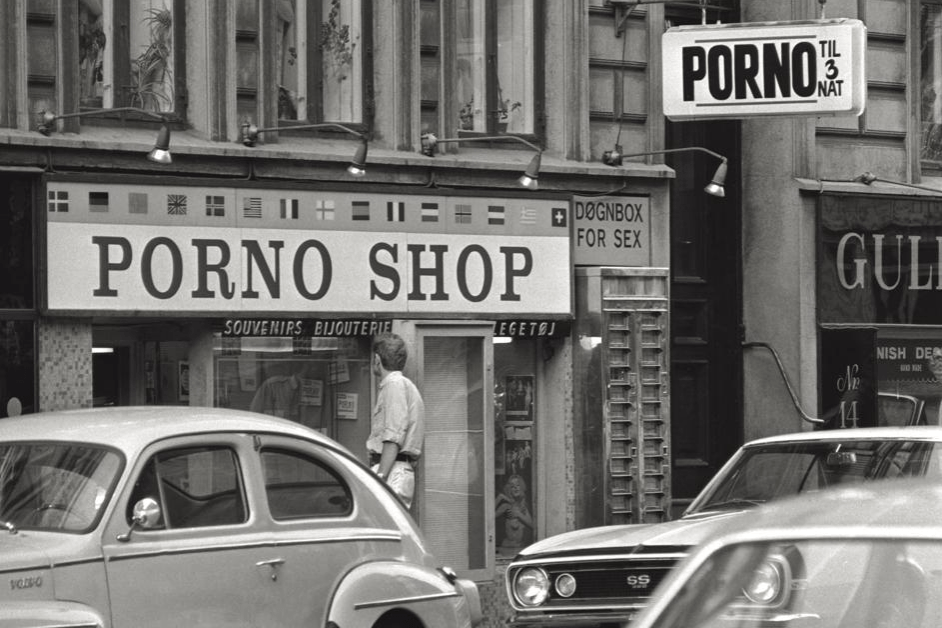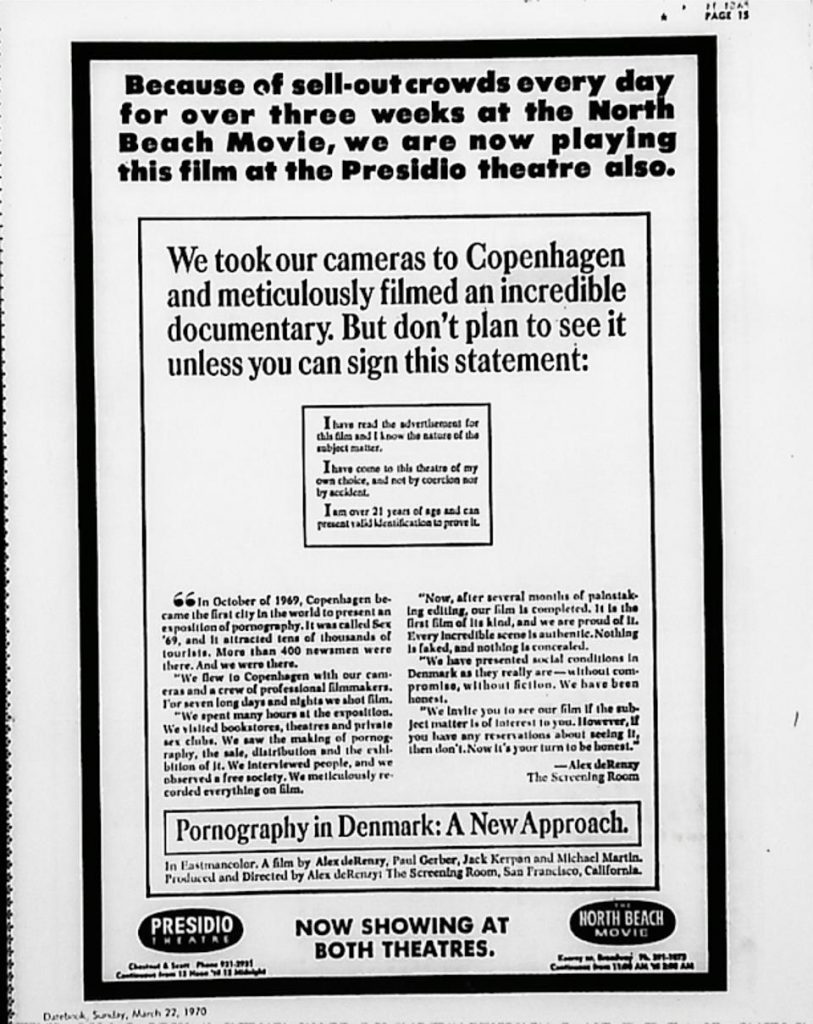Fifty years ago something new and exciting was taking place in Copenhagen, Denmark. The Scandinavian country had lifted the ban on pornography on July 1, 1969, and on October 21, 1969, the world’s first pornography trade show was about to kick off.
Reporting on the trade show, the UK’s Observer newspaper wrote that Denmark’s export market for sex books and films was already worth $3.8 million a year. In the U.S. the open sale, exhibition, and distribution of porn was still prohibited. The 1969 Stanley v Georgia ruling helped establish the “right to privacy,” which meant individuals could not be convicted merely for possessing obscene materials, but the nature and definition of “obscenity” was being, had long been, and would continue to be thrashed out in the courts.

Meanwhile, in Denmark, some 50,000 people flocked to “Sex 69,” as the trade show was titled, including American filmmaker Alex de Renzy who was shooting a documentary about the show. “Censorship in Denmark – A New Approach” was released in the U.S. in 1970. It comprised reports from the trade fair alongside vox pops from around Copenhagen. But what made it notable was the inclusion of scenes in which the hardcore erotic movies that were being screened at “Sex 69” were clearly shown. While the movies themselves would have been illegal to screen in American cinemas, “Censorship in Denmark” was able to circumvent this on account of being a documentary.
As The New York Times reported at the time: “‘Censorship in Denmark’ manages to display a lot of the product itself. There are still pictures, movies, a visit to the set of a porno film, live shows as they are being performed in porno clubs—all framed, and thus, apparently legally protected here, by the fact that this is, after all, a movie about pornography.”
Cut to 2019 and the Berlin porn film festival is gearing up for its 13th year, showing upwards of 100 adult movies across six days. It’s hard to gauge the size of today’s online porn industry—and it is notoriously difficult to crunch the numbers—but estimates range from $6 billion to $97 billion. So how did we get here?MORE FOR YOUThis Brother-Sister Duo Relocated from Tennessee To California To Live Their Cannabis Business DreamsPennsylvania Could Be Next State To Legalize Recreational CannabisChewing Gum Billionaire Beau Wrigley To Take Cannabis Company Public Through SPAC Deal

De Renzy’s wasn’t the only film to make waves that year. Andy Warhol’s controversial “Blue Movie” was also released in 1969 and was the first movie to show explicit “real sex.” Like “Censorship in Denmark” it got away with its “obscene” content on account of being considered art. Indeed, Warhol is quoted in Victor Bockris’ biography of him as saying: “‘Blue Movie’ was real. But it wasn’t done as pornography—it was done as an exercise, an experiment.”
From 1969 to 1984 there followed what is now known as the Golden Age of Pornography, when even very low-budget adult films were able to achieve box office success. By 1975, the retail value of all the hardcore pornography in the U.S. was estimated at $5 million to $10 million (equivalent to $24 million to $48 million today).
Advances in technology forced change in the way business was done. The arrival of VHS, the VCR and the camcorder in the early 80s made it much cheaper to shoot, produce and adult films. While seventies films such as the famous “Deep Throat” starring Linda Lovelace had focussed on high production values, complete with script and storyline, the 80s saw the emergence of “amateur” porn.

Then, in the 1990s, DVD and the Internet changed the way porn was delivered. More people than ever were now able to access and view porn. It also changed the way money was made. While people were still, at that time, prepared to pay to access adult images and videos, online advertising meant that those hosting this content didn’t have to rely on its revenue alone. In “The Players Ball: A Genius, a Con Man, and the Secret History of the Internet’s Rise” author David Kushner wrote: “While [website owners] might sell membership subscriptions—charging visitors a monthly fee to access photos, videos, and so on […], the trick was getting surfers to click a banner ad, the interactive billboards of the information superhighway, and visit a site.”
In 2007 three key things happened: Free streaming of online porn arrived in the form of “tube” sites such as Pornhub and XHamster, the first iPhone was released, and Vivid Entertainment published Kim Kardashian’s sex tape. The socialite was barely known at the time—and certainly not the first celebrity to make and have a sex tape leaked—but the ease with which the video could be accessed, meant that it drew an unprecedented audience. “For a long time Kim Kardashian was the most-searched term on XHamster,” says journalist, filmmaker and member of the adult industry’s Free Speech Coalition, Mike Stabile.
It was now possible to go online—on either a computer or your phone—and search for almost any kind of scene. This “tech takeover” of the adult industry was the central line of enquiry in British journalist Jon Ronson’s 2017 audio documentary, “The Butterfly Effect”. But with these developments came increased piracy. Users copy paid-for films and upload them to the tube sites where thousands of people can watch them for free. Ronson heard from directors, producers, performers, how this barely-controlled piracy has impacted the industry.
In 2015, Nate Glass, owner of Takedown Piracy, a copyright enforcement service, told CNBC he sends out close to 25,000 copyright law notices a year to tube sites. “Companies aren’t required to make yearly revenues public,” he was quoted as saying. “However, you can see the decline in production where fewer companies are shooting new content and there’s less work for performers. Back in 2009 when I was working for studios we saw about a 50 percent drop in DVD sales over the course of the year; that’s when the slide really began.”
In her book, “The Pornography Industry What Everyone Needs to Know,” Shira Tarrant estimates that porn piracy costs the industry around $2 billion a year. Performers themselves also earn less. In 2012, adult industry agent Mark Spiegler said that performers were making about half of what they earned at the turn of the 21st century. “A decade ago the average female performer would make about $100,000 a year,” he said. “She now might make as little as $50,000.”
But it’s not just the means of production and distribution that have changed. The market has changed dramatically too. At Copenhagen’s “Sex 69,” the Observer journalist wrote: “The visitors have been 90% men. The women have been strolling around as though they were at a church jumble sale.” Now, women make up almost 30% of Pornhub’s visitors (NB link does not contain adult content).
There are also more independent porn studios, and autonomy for porn performers who regularly use their social media platforms to talk openly and thoughtfully about the adult industry. Some have even turned their hand to sex education, while others have spoken out about labour rights and #MeToo abuse scandals.
There are porn film festivals in Berlin, Vienna, London, not to mention Dan Savage’s touring Hump! Festival. When we look back at the last 50 years, it’s easy to believe we’ve come a long way. But while the laws, the industry, and the audience have changed, there remain some parallels in the social attitudes of 1969 and 2019.
In response to another critic, who’d described “Censorship in Denmark” as “mind-boggling”, New York Times journalist Vincent Canby wrote: “It may boggle the mind, but only after it boggles, shakes up and threatens a lot of other things that are more difficult—and less fashion able—to talk about, including the Puritan conscience and our traditional sexual taboos, which we all have (whether we admit it or not) and which have nothing to do with the mind, but with emotions.”
Apply the above to any adult content currently under debate, and Canby’s words still manage to ring true today. Only this week, the UK government finally dropped its controversial age-verification “porn blocker” plan after months of debate, amid protests from sex educators and freedom of speech campaigners. Despite the size of the industry, and the apparent appetite for it, porn is still something we struggle to talk about.
However, one thing is for sure, as every historical summary of the adult industry must conclude: Porn isn’t going anywhere.

